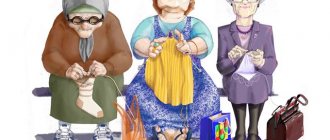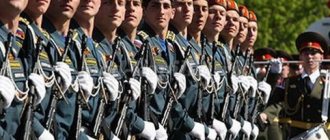Extracurricular event “How the New Year is celebrated in different countries of the world”
Summary of an extracurricular event for schoolchildren on the topic: “How people of all latitudes celebrate the New Year”
Purpose: to introduce students to the features, traditions and customs of celebrating the New Year among different peoples of the world. Objectives: - expand the horizons of students; - develop fantasy, imagination, artistry; — develop the ability to evaluate the work of other students. Equipment: New Year's stocking with cards, illustration of a New Year's tree, figured Santa Claus and Snow Maiden, blank costumes, educational presentation.
Progress of the event:
I Introductory conversation
On the eve of the holiday, New Year. Tell us how you usually celebrate this holiday? Indeed, we all celebrate the New Year in a similar way. But how do residents of other countries do this? After all, every country and people have their own customs and traditions for celebrating the New Year. Listen here.
II Introduction to new material
There is a legend about the creation of this holiday.
New Year is the oldest winter holiday, otherwise known as the Sakai
, which began to be celebrated for the first time in
Babylon
around 3000 BC.
According to Babylonian legend, the earth was created by the god Marduk
on the first day of the new year after a terrible battle
with the monster Tiamat
. Marduk won. He killed Tiamat and cut him in two to create Earth and Sky. Every year, celebrating a new holiday, the Babylonians, in memory of Creation Day, staged a colorful costume performance depicting the battle of Morduk and Tiamat.
In
China
, the New Year is celebrated on the first day of the lunar month, between mid-January and mid-February. This is the most spectacular of Chinese holidays. The celebration in China lasts almost a whole month. Solemn processions walk through the streets, parades are held with music and dancing. Friends and relatives visit each other, exchange gifts, and children are given coins in red envelopes (“lucky money”).
In
Japan,
New Year is celebrated for three days, starting on January 1st.
The arrival of the New Year is announced by 108 strokes of the bell, which is rung in Buddhist temples. According to beliefs, a person is burdened with 108 worries, and with the last strike of the bell they become a thing of the past. After this, people go to the mountains or to the sea to greet the dawn and perform a sacred ritual: to clap their hands at the first ray of sun. In Greece,
at exactly 12 o'clock at night on December 31, the mother of the family goes out into the yard and smashes a pomegranate fruit against the wall of the house. If its seeds scatter throughout the yard, then the family will live happily in the coming year.
Do any of you know how to celebrate the New Year in Italy?
In Italy
, on New Year's Eve, residents throw unnecessary household utensils (cracked dishes, broken furniture, old things) from their apartments and houses directly onto the street or into the yard. It is believed that this will bring prosperity to the family in the new year.
All countries and peoples are united by the same New Year symbols. What or who do you think it is?
III Competition "New Year's Questions"
1. In what city does Santa Claus live?
( Veliky Ustyug
) 2. Where does Santa Claus live?
( in Lapland
) 3. Our Father Frost is accompanied by the Snow Maiden, and who accompanies Santa Claus?
( elves and gnomes
) 4. Which Russian writer invented the Snow Maiden?
( A.N. Ostrovsky
) 5. Who launched the first rocket in Russia in honor of the New Year holiday?
( Peter I
) 6. Which tree was the predecessor of the New Year tree among the ancient Slavs?
( cherry
) 7. How old is Santa Claus?
( despite the rich pedigree of characters from ancient fairy tales, tales and legends about New Year's wizards, the image of modern Santa Claus (in his usual attire, with a staff and with a bag of gifts over his shoulder) is about 150 years old
)
IV Competition “Gift from Santa Claus”
As you know, in European countries Santa Claus puts gifts in socks. In front of you is such a sock, but it contains not gifts, but cards with winter and New Year themes. It is necessary to take out one card so that the class does not see it and show with facial expressions and gestures what is depicted on it. The one who guesses becomes the leader and draws the next card.
V Competition "Fashion Designer"
Students are divided into two groups: a group of girls and a group of boys. Pictures of Father Frost and Snow Maiden hang on the board. Task: come up with and draw costumes for the main characters. Girls draw a costume for Santa Claus, boys - for the Snow Maiden. To do this, each child receives a costume template. Based on the results of the competition, an exhibition and fitting of all costumes is organized. Girls choose the best costume for Santa Claus from the presented ones, boys choose the best costume for the Snow Maiden.
On this positive note, we end our educational and entertaining event and organize a festive table.
We recommend watching:
Scenario of a New Year's fairy tale for primary classes New Year's scenario, grades 2-3 Teremok. New Year's fairy tale for primary schoolchildren Scenario of the New Year's holiday in elementary school
Similar articles:
Scenario of the New Year's performance for primary schoolchildren
Conversation on the topic New Year with children in grades 1-2
Lesson on the topic New Year in the GPA
Extracurricular activity on the topic New Year for grades 1-2
Scenario of extracurricular activities for the New Year in elementary school
Traditions of the countries of America
America is a country very diverse in mentality and customs. Each nationality has its own flavor in celebrating the New Year, we will tell you about the most interesting ones.
Celebration in the USA
The New Year's symbol of the Americans is a child (Baby) in a diaper, which, according to their beliefs, grows and ages within a year, transferring its powers to the next baby every December 31st.
A spectacle that attracts more than a billion viewers from all over the world is the fall of a huge colored ball during the last minute of the year from a 23-meter height in Times Square. The tradition has existed since 1907.
Each state interprets it in its own way, and in different parts of the country, giant peaches (Georgia), acorns (North Carolina), and ping-pong balls (Pennsylvania) descend to the ground on New Year's Eve.
Canada
Oddly enough, Canadians are close to us in the tradition of swimming in ice holes in winter. But they do this not on Water Baptism, but on December 31st. They call this ritual “polar bear bathing” and those who perform the ritual will have a healthy year ahead.
Even in Canada, it is not customary to give expensive gifts for the New Year; Canadians limit themselves to small souvenirs for friends and family.
In addition, residents of the country eat pea soup the day before. They jokingly claim that the “musicality” with the smells that it evokes scares away evil spirits on a festive night. This is the custom of Canadians of French origin who inhabit the largest province of the country - Quebec. The soup should be thick, and yellow peas are chosen for it.
Argentina
On New Year's Eve in Argentina, it is customary to throw irrelevant papers out of the window: old calendars, statements, documents that lose their validity in a matter of hours. By noon on December 31, the country's sidewalks are thickly covered with papers. Where and how the tradition originated is unknown.
There is a story about how temperamental Argentines once went too far. Employees of one of the country's newspapers tried so hard to clear their offices of old papers that they threw the entire archive out of the windows.
Brazil
For Russian people, New Year is associated with a frosty winter with snow slides and cold. In Brazil, this holiday takes place when the weather is hot and sunny. On this day, every resident of the country brings gifts to the goddess Imanji, who is identified with the Christian Virgin Mary: snow-white flowers and small candles. They are released into the sea: flowers are simply thrown, and lit candles on flat wooden boards are carefully placed on the water. The spectacle is very beautiful. At the same time, Mexicans make a cherished wish and firmly believe that it will come true if the flowers float far away and the candles do not fade for a long time. These rituals have African roots.
Another interesting custom, similar to the Italian one, is to eat 12 grapes at the last minute of the passing year. In Brazil, there is no chime; the population, cheerfully celebrating the New Year in the company of friends, counts out the last seconds out loud and in unison.
Mexico
Mexicans celebrate the New Year for at least nine days. In this state, the holiday is associated with fun and carnivals, during which scenes from Bible stories are played out.
Like the people of Brazil, Mexicans eat 12 grapes on New Year's Eve.
Here it is customary to break clay pots (pinatas) in the shape of stars or animals, filled with sweets. Children love the activity, although its meaning is adult - the vessel symbolizes sins that are forgiven before the New Year, and gifts serve as payment for faith in God.
Peru
If in some countries on the eve of the New Year it is customary to get rid of old things, then in Peru people at this time shed negativity through fights. On city streets at the end of December you can find men and women of all ages beating each other - from children to the elderly.
Peruvians who want to travel in the New Year must jump out of their homes at 11:55 pm on December 31st with a huge suitcase and run around their entire neighborhood with it until midnight. Returning home, the out of breath resident of the country, like his neighbors on the continent, eat grapes, but not 12, but 13 berries. They believe that it is the last grape that brings good luck in the new year.
On a festive night, the girls of Peru can still choose a mate - they go out with willow twigs and the guys they touch with them become their chosen ones.
Celebrations in the country's squares are accompanied by the ritual burning of an effigy of the outgoing year. To make it more fun, they stuff firecrackers into his clothes. Thus, in addition to the fire, there are also fireworks.
New Year's traditions of Australia and Micronesia
During the New Year celebrations in distant Australia there is no snow or frost, but, like all year round, there is a warm ocean. Therefore, Santa Claus appears from the water on the surf in a surfer suit, the colors of which are identical to the outfit of the classic Santa Claus. A beard and a traditional hat are a must, looking original when paired with red beach trunks and a large bag of gifts. The spectacle is original, exotic and humorous - just like the mentality of Australians in general.
On a festive night, it is customary to visit crowded open-air places where fireworks are set off. Most Australians go to bed at 00:10, immediately after New Year's Eve - this is due to their national tradition of going to bed early. But young people can celebrate noisily until the morning.
Until January 6, it is customary to organize New Year's parties and picnics.
Micronesia
Among all the countries in the world, Micronesia is distinguished by its originality.
A mandatory event every year is the change of name for every resident of one of the Caroline Islands. The goal is to drive away evil spirits and evil spirits. The ritual goes like this: on the morning of January 1st, family members cover their mouths with their hands and tell each other their new names. At the same time, they appoint someone responsible for protection from evil spirits, who, with all his strength, plays a tambourine so that the noise does not allow them to hear new names. Having gone outside and met a neighbor, the inhabitants of this island squat down and tell each other their new names in a whisper.
Our planet is amazing in its diversity and New Year's traditions in different countries are clear proof of this. In addition to the listed features of the holiday, each nationality is interesting with its cuisine and attire. Which customs did you like the most?
New Year traditions of African countries
Africa is mysterious. This is a separate world with its own beliefs, rules and views on life. But the presence of many countries as part of the colonies of France and Spain left their mark - despite the frequent refusal of the population to accept the traditions of the ruling country, African states still “Europeanized” in some issues.
Cameroon
In this country, on New Year's Day, every adult whom a child congratulates is obliged to give him a coin. In this way, local residents appease the spirits. The children of Cameroon are happy to try to congratulate everyone, make noise and have fun, emptying the wallets and pockets of passers-by. Therefore, many adult residents even try not to leave the house on this day.
Nigeria
A special feature of Nigeria's traditions is that only men participate in New Year's parades and masquerades. Theatrical actions are performed, the essence of which is necessarily the victory of good over evil.
Burning torches in the hands of local residents serve as evidence of the coming of the New Year. Nigerians make them with their own hands.
Ivory Coast
A very unusual and interesting tradition of celebrating the New Year in Cote D'Ivoire. Local residents are divided into 63 tribes and in one of them it is customary to organize original competitions. Their essence is that participants race on all fours, carrying a raw egg in their teeth. It symbolizes the birth of the coming year, and its shell reminds of the fragility of life in general.






